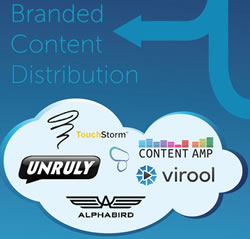
UK-based content marketing agency Content Amp released an impressive infographic, mapping the content marketing software, tools and partner ecosystem.
‘The Content Marketing Landscape Infographic’ does more than categorizing and summing up some content marketing software platforms. It also looks at websites, social networks, resources and tools regarding all aspects of content marketing and related marketing tactics.
The way the infographic is structured by Content Amp shows why and how content marketing is being increasingly used today and is a snapshot of content marketing anno 2013 with the converged imperative of the three sets of digital marketing tactics all content marketers are looking at. An overview, some conclusions and a look at the state of content marketing as it’s seen now in most cases, as reflected by the map.
‘The Content Marketing Landscape Infographic’ categorized and analyzed
There are a few main categories in ‘The Content Marketing Landscape Infographic’, showing how a holistic content marketing approach is perceived by the content marketing agency:
- Search engines.
- Search engine marketing tools.
- Content creation.
- Content sharing.
- Social networks & other.
- PR distribution.
- Analytics.
Each of the categories is divided into different subcategories and shows the logos of some players and software platforms or agencies, obviously mentioning Content Amp as well. The categorization of the platforms is not bad at all. There are some interesting subcategories we include in our ongoing content marketing software categorization and review efforts as you’ll soon discover. Some categories are somewhat strange. Calendar tools, for instance, are ranked under SEM tools. Nevertheless, it’s certainly worth a good look.
Even if the categorization is not complete, the infographic most of all shows how vast the content marketing landscape is, certainly when looking at the different platforms and content marketing software enabling you to fulfill some steps in the content marketing strategy, planning, production and measurement process and realizing that there is much more as you’ll read in an instant.

Some of the covered content marketing processes/tasks:
- Keyword analysis.
- SEO research.
- Content marketing planning (editorial calendars).
- Content creation tools.
- The agency/partner/resource ecosystem.
- Blogging platforms.
- Branded content distribution.
- Content sharing.
- Content curation.
- Social listening.
- Search analytics.
- Web analytics.
- Etc.
The holy content marketing trinity anno 2013: search, social and content
What strikes me most of all is that, as the infographic shows, the content marketing landscape is predominantly seen from the increasingly clear 2013 view on content marketing. Let’s call it the ‘modern’ view. First of all, it’s all about digital content marketing (and that’s a normal evolution when looking at the customer journey). Secondly, the main aspects that are emphasized can be grouped in what I notice many of us see as the holy – integrated – trinity of content marketing, even if it really started booming in 2012, with among others Lee Odden’s book Optimize):
- Content (marketing) as such (mainly sourcing, creating, sharing and curating).
- Search engine marketing (mainly optimization).
- Social media marketing (mainly social sharing).
This focus is entirely understandable. The growing attention for content marketing is coming from social media (both go hand-in-hand) and from post-Penguin search engine marketing requirements.
However, we shouldn’t forget that content marketing is so much more than that. It’s not just about the holy trinity or the ‘modern’ view that focuses on social and search. It’s about an overall content marketing view in which buying persona definition, content gap analysis, content mapping, lead management and progressive conversion are all very important pieces. The holy trinity, in the end, should be customer (experience), profit (conversion) and context.
Content marketing: don’t forget the business, math and ROI: a prediction
In ‘The Content Marketing Landscape Infographic’ many of these pieces are missing, also from a marketing software and related tools perspective. Don’t misunderstand me: this is in no way an attempt to criticize the efforts of Content Amp. On the contrary: I encourage such efforts. Nevertheless, I do hope that we don’t forget all the other aspects of content marketing. I’m realistically enough that the content many of you like most is about how to get more reach, fans, retweets, social content sharing, juicy links, etc. using content marketing.
However, as with all things sooner or later someone will pull the plug if the customer-centric and overall business case and proven ROI are not there. And this requires more than search and social. It’s also about CRM, customer experience management, touchpoints, cross-channel integration, customer service and all that other stuff I’m boring you with. And, yes, good website content is still important too.
But even if my “message” sounds boring: just look at what happened with social media marketing. While many of us are still discovering the basics (and that’s OK), some business have made it an essential part of their business and marketing strategy. And some have also pulled the plug. Maybe they are the ones that didn’t see the full picture?
My prediction: the content marketing map of 2015 will be much less about search and social and much more about the customer, goals and overall view. If it’s not, some business will have pulled the content marketing plug as well because they focused too much on tools, channels and short-term tactics without thinking processes, outcomes and overcoming the silos.
Watch ‘The Content Marketing Landscape Infographic’ below. And here’s the press release announcing it.


